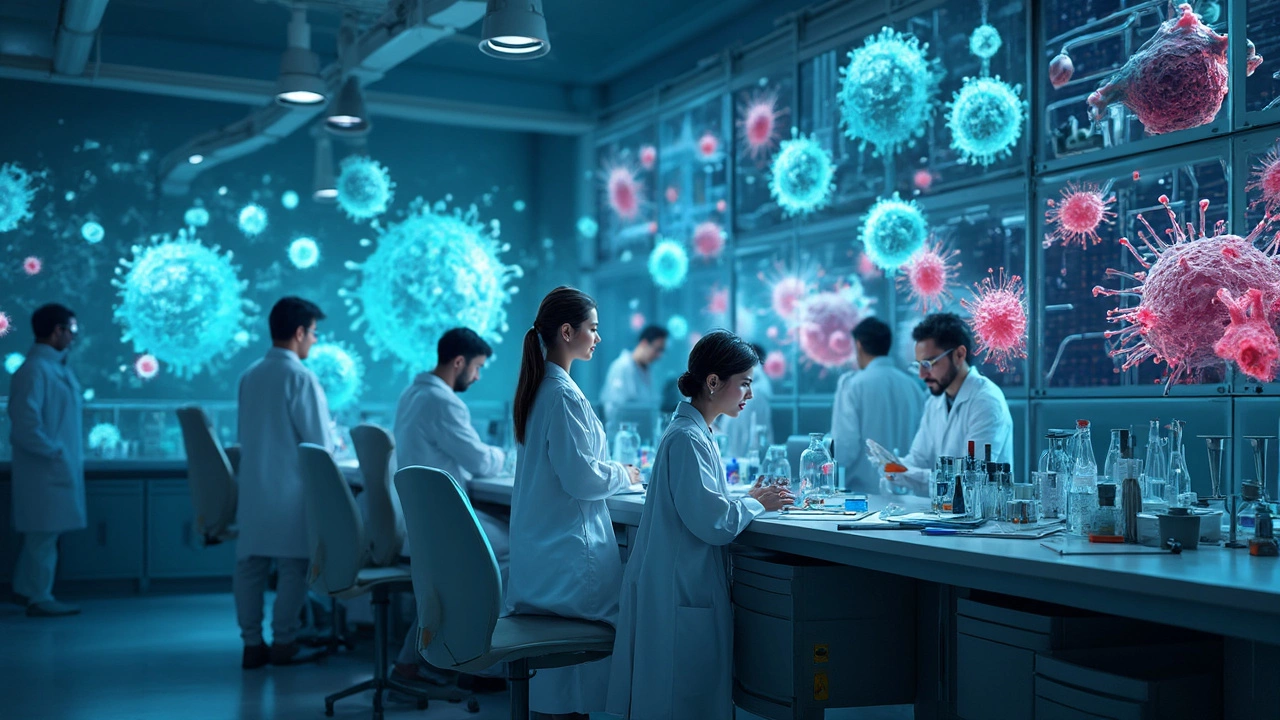Cancer can be a scary word, right? We often hear about it and immediately think about the worst. Some cancers, thankfully, can be treated effectively, and people go on to live long lives. But there's another side to this story. Some types, no matter how high-tech our treatments get, remain a tough nut to crack.
So, let's tackle the big question—why are some cancers just not curable? For starters, it's all about how that sneaky cancer behaves. Different cancers grow differently, spread differently, and sometimes even hide away from our best treatments. What's even harder is when they spread to places where treatment can't easily reach. Pancreatic cancer and certain brain cancers are prime examples of these challenges.
But don’t lose hope! Research is ongoing, and each discovery gets us one step closer to finding better solutions. In the meantime, knowing more about these cancers helps in planning, managing expectations, and supporting those who face them. Stay informed, stay hopeful, and remember that being well-prepared and knowledgeable can make all the difference in the journey ahead.
- Understanding Cancer Curability
- Why Some Cancers Are Incurable
- Focus on Pancreatic Cancer
- Challenges in Treating Brain Cancer
- Living with Incurable Cancer
Understanding Cancer Curability
Alright, let's break it down. Cancer, in general, includes over 100 different diseases, all characterized by uncontrolled cell growth. But when we talk about cancer treatment, things get a bit tricky. Why? Not all cancers react to treatments the same way.
Imagine the body's cells as students in a classroom. Most listen to instructions and behave. Cancer cells, on the other hand, throw out the rulebook. They grow and multiply without stopping and can invade nearby tissues, making matters worse.
The curability of cancer depends on several key factors:
- Type and Stage of Cancer: Some cancers like certain skin cancers, when caught early, are very curable. But if they spread to other parts of the body, they become harder to treat.
- Location in the Body: The exact spot of the cancer can determine how accessible it is for surgery or treatment. Brain cancer, for instance, involves delicate and complex treatments.
- Availability of Treatment: Access to advanced treatments and technology plays a massive role in how curable cancer can be.
- Individual Health: Things like age, overall health, and how one responds to treatment can sway the curability scale.
Modern medicine has made leaps and bounds in the battle against cancer. For some cancers, what used to be a grim diagnosis now comes with a decent survival rate. Statistics show how early detection and personalized treatments have improved survival rates for several cancers.
| Cancer Type | 5-Year Survival Rate Increase |
|---|---|
| Breast Cancer | +20% |
| Prostate Cancer | +15% |
| Melanoma | +25% |
Understanding which cancers aren't curable is essential for focusing research and resources where they're needed most. While the fight is far from over, every small victory in research and treatment counts.
Why Some Cancers Are Incurable
Ever wonder why some types of cancer seem unbeatable? Well, it boils down to a few tricky factors. For one thing, some cancers have a nasty habit of spreading quickly. By the time they're detected, they've often moved to other parts of the body, making them much harder to treat effectively.
Take pancreatic cancer, for example. It's a notorious silent mover. It tends to show up without any major symptoms until it's really spread, which doesn't give doctors much time to act. It’s like trying to chase the wind—hard to find and harder to catch.
Another big hurdle is the location. Certain cancers, like brain tumors, are tough to reach with standard treatments like surgery or radiation without causing damage to critical areas. Imagine trying to fix wiring in a live electric grid—one wrong move and everything's a mess.
The nature of the cancer cells themselves also plays a part. Some cells are incredibly resilient and can resist even the strongest treatments we throw at them. This makes them almost like a fortress, ready to repel any attacks.
For an example of how tough cancer can be, here’s a quick look:
| Type of Cancer | 5-Year Survival Rate | Main Challenge |
|---|---|---|
| Pancreatic | 10% | Late detection |
| Glioblastoma (brain cancer) | 6% | Difficult access, resistant cells |
All these factors combined make certain kinds of terminal cancer incredibly challenging to treat. But there's always hope, with new treatments and research constantly pushing boundaries. So, while some cancers are labeled as incurable today, that doesn't mean they'll remain that way forever. Science loves a challenge, after all.

Focus on Pancreatic Cancer
Pancreatic cancer is one of those tough cancers that often gets diagnosed late. Why? Because it quietly grows without showing signs until it's advanced. This stealthy behavior makes it a prime example of an incurable cancer challenge we face today.
So, why is it particularly notorious? Well, the pancreas is located deep in the abdomen, surrounded by other organs. This hidden spot makes it hard to detect early. By the time symptoms like stomach pain and jaundice pop up, the cancer has usually spread beyond just the pancreas, making treatment trickier.
A significant issue is that this cancer has a knack for resisting treatment. Even with modern treatments like chemotherapy and targeted therapy, it doesn’t always respond well. This resistance means that for many patients, the focus shifts from curing to managing the disease, controlling symptoms, and improving quality of life.
On a brighter note, research is slowly chipping away at the mysteries of pancreatic cancer. New therapies and early detection methods are being developed, offering a glimmer of hope. Like other cancers, the key remains in early detection, so those at high risk should keep a close eye on any unusual changes and consult their doctors.
Taking a proactive approach can make a world of difference. Even in the face of tough battles, understanding the nature of pancreatic cancer can lead to better outcomes and a stronger support system for those affected.
Challenges in Treating Brain Cancer
Brain cancer can be one of the scariest diagnoses, and for good reason. It’s not just about having a tumor; it’s about where that tumor is located and how it affects everyday functions that we usually take for granted. The biggest challenge? The brain is like the control center of a spaceship, and any damage can have a ripple effect on the entire body.
First up, we've got the blood-brain barrier to deal with. This protective shield is great for keeping out harmful substances, but it also keeps many cancer treatments from reaching the tumor. That makes delivering effective doses of drugs super tricky.
Then there’s the type of brain cancer itself. Glioblastoma is one of the most common and unfortunately, one of the most aggressive and incurable cancer types in the brain. It's a real tough one because it grows super fast and has a habit of spreading quickly.
Surgery might sound like a straightforward solution, right? But with brain tumors, it’s not always that simple. Many times, it’s hard to remove the entire tumor without affecting crucial areas responsible for speech, movement, or other vital functions.
Let's not forget the side effects of treatments like radiation and chemotherapy. They can lead to swelling and other complications that might not just affect the cancer cells, but also the healthy parts of the brain.
Even with all these challenges, the landscape isn’t entirely bleak. New treatment approaches, like targeted therapies and immunotherapy, are showing promise. These treatments focus on killing cancer cells while sparing healthy brain tissue.
Researchers are committed to finding solutions, improving quality of life, and extending survival rates, even if complete remission remains elusive. Staying informed and supportive of ongoing research can make a difference in this fight against terminal cancer.

Living with Incurable Cancer
Living with a diagnosis of incurable cancer can feel overwhelming, but it doesn't mean life comes to a halt. Many people find ways to maintain a quality of life and even pursue their passions despite this challenge.
First things first, managing symptoms to stay comfortable is a huge part. Medications and therapies are available that help with pain and other discomforts. Whether it's fatigue, nausea, or other symptoms, discussing these openly with your doctor can lead to better solutions.
Another important aspect is support. Surrounding yourself with family, friends, or support groups can make a big difference. Knowing you don't have to face this alone brings emotional relief and strength. There's something about sharing experiences with others who get it that makes tough times a bit more bearable.
If you're open to trying new things, exploring complementary therapies like meditation, yoga, or acupuncture might offer some added comfort. They're not a fix for cancer, but they can help manage stress and improve overall well-being.
- Schedule regular check-ups: Regular medical appointments ensure that treatments are working as best as they can and any new symptoms are quickly addressed.
- Adapt your lifestyle: Eat well, stay active in ways that suit your energy levels, and get enough rest. These changes can help you feel stronger.
- Stay informed: There's always ongoing research in the world of cancer treatment. New trials or emerging therapies might become options.
Keep in mind that embracing a positive mindset, without being overly optimistic or unrealistic, is powerful. It's about focusing on what can be controlled and enjoying life's small pleasures. Whether it's spending time with loved ones, reading a good book, or simply savoring a sunny day, these moments matter.



